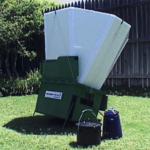Search engine visitors - click here to access entire "$ensible Home" web site
Click here to see a descriptive illustration showing several types of solar cookers/ovens.
Dear Jim: Our kitchen was hot last summer, and with potential Y2K problems this winter, I am considering getting or building a simple solar cooker/oven. Do they really work and will using one lower my utility bills much? - Sue C.

A: Solar cooker/ovens work great. Hundreds of millions of people across the world use nothing but solar cookers year-round. They even work in subzero temperatures on peaks like Mt. Everest. These solar units reach temperatures of 400 degrees adequate for almost any cooking or baking.
Your utility bills savings may be only $10 per month in the winter. In the summer, however, it is much higher because using one reduces heat buildup indoors and the load on your air conditioner. Also, cooking outdoors with the sun reduces the allergy problems associated with high indoor humidity.
Consider this. If your neighbors' power goes off on January 1 (Y2K), think how much you can charge them for a hot cup of coffee or a steamy piece of pizza. Remember, if the electricity goes off, even a gas or oil furnace will not run, so a hot cup of solar-heated coffee will be greatly appreciated.
You have several solar cooker options, from a simple DIY design costing $10 to build with old cardboard boxes to a ready-to-use cooker costing $400. These are high-quality cooking/baking appliances that will last a lifetime. Most are lightweight (20 to 30 pounds) and collapsible for easy handling.
The best solar cooker/ovens are made with durable fiberglass or steel housings. When the top is folded out, it exposes many mirrored surfaces that direct the sun's heat to the cooking chamber inside. The cooking chamber is covered with glass to hold the heat in like a greenhouse does.
With the radiant heat from the sun, foods cook very evenly in a solar cooker/oven with little stirring needed. It is also healthy cooking. For example, like in a microwave oven, little water is needed for cooking vegetables.
One unique model (Best Solar Products) has an attractive cover that converts to a 36-inch patio table when you are not cooking. Another model (Solar Chef) is mounted on wheels so you can roll it like a barbecue grill.
You can build your own solar cooker in a couple of hours. It needs a glass top, a door on the back and a rack inside to hold the pots. Line it with rigid foil-covered duct insulation and paint the foil black to absorb heat.
A 24-inch cube is a good size. This allows room to add a few bricks for stabilizing thermal mass. Add some vent holes, with adjustable flaps, to control the temperature. Its effectiveness can be increased by adding cardboard reflectors that are covered with aluminum foil or Mylar.
Instant Download Update Bulletin No. 537 - buyer's guide of ready-to-use solar cooker/ovens, descriptions, features, prices, do-it-yourself instructions for making a plywood solar cooker, a low-cost cardboard solar cooker, a single hot dog cooker that makes a wonderful boy/girl scout project, solar box cooking tips and unique solar cooking recipes.
Dear Jim: I use magnetic plastic storm windows in my house. They were a lot cheaper than new windows. Is there a certain outdoor temperature when I should get them out of the garage and put them up? - Karl V.
A: Interior magnetic storm window kits are tremendous money savers. I use one under my large skylight and leave it up year-round. They not only cut your utility bills, but they reduce fading of furniture and carpeting.
Put up your storm windows on any windows as soon as you no longer plan to open them. You may want to wait a while to put them up on one or two windows in case you want some fresh air on milder days.